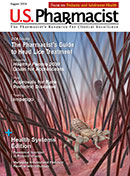Boston—Prescriptions for semaglutide appear to be associated with an increased risk of nonarteritic anterior ischemic optic neuropathy (NAION) in patients with type 2 diabetes (T2D) or patients who are overweight or obese, according to a new observational study.
The researchers from Harvard T.H. Chan School of Public Health, Harvard Medical School, and affiliated hospitals identified the possible link in a matched-cohort study of 16,827 subjects. The results, published in the Journal of the American Medical Association Ophthalmology, suggested that patients who were prescribed semaglutide faced a higher risk of NAION compared with patients prescribed non–glucagon-like peptide 1 receptor agonist (GLP-1 RA) medications for diabetes or obesity.
“The findings suggest a potential risk of NAION associated with prescriptions for semaglutide, but future study is required to assess causality,” the researchers advised.
The study team embarked on the study after anecdotal experience raised the possibility that semaglutide, a GLP-1 RA with rapidly increasing use, is associated with NAION. The retrospective matched-cohort study using data from a centralized data registry of patients evaluated by neuro-ophthalmologists at a single academic institution from December 1, 2017, through November 30, 2023; researchers searched for International Statistical Classification of Diseases and Related Health Problems, Tenth Revision code H47.01 (ischemic optic neuropathy) and a text search to yield 16,827 patients with no history of NAION.
Propensity matching was used to assess whether prescribed semaglutide was associated with NAION in patients with T2D or overweight/obesity. In in each case, the study accounted for covarying factors such as sex, age, systemic hypertension, T2D, obstructive sleep apnea, obesity, hyperlipidemia, and coronary artery disease, as well as contraindications to semaglutide use.
Among the participants, 710 had T2D, with 194 prescribed semaglutide and 516 prescribed non-GLP-1 RA antidiabetic medications. The participants’ median age was 59 years, and 52% were female. In addition, 979 were overweight or obese, with 361 prescribed semaglutide and 618 prescribed non-GLP-1 RA weight-loss medications. Their median age was 47 years, with 72% women.
“In the population with T2D, 17 NAION events occurred in patients prescribed semaglutide vs 6 in the non-GLP-1 RA antidiabetes cohort,” the researchers reported. “The cumulative incidence of NAION for the semaglutide and non-GLP-1 RA cohorts over 36 months was 8.9% (95% CI, 4.5%-13.1%) and 1.8% (95% CI, 0%-3.5%), respectively. A Cox proportional hazards regression model showed higher risk of NAION for patients receiving semaglutide (hazard ratio [HR], 4.28; 95% CI, 1.62-11.29); P <.001).”
The researchers added that in the population of patients who were overweight or obese, 20 NAION events occurred in the prescribed semaglutide cohort versus three in the non-GLP-1 RA cohort. “The cumulative incidence of NAION for the semaglutide vs. non-GLP-1 RA cohorts over 36 months was 6.7% (95% CI, 3.6%-9.7%) and 0.8% (95% CI, 0%-1.8%), respectively. A Cox proportional hazards regression model showed a higher risk of NAION for patients prescribed semaglutide (HR, 7.64; 95% CI, 2.21-26.36; P <.001),” the authors added.
Background information in the articles noted that NAION is the second most common form of optic neuropathy and a significant cause of blindness among adults.
“In major medical centers, neuro-ophthalmologists are most likely to evaluate suspected cases of NAION,” the authors explained. “This study was designed to capitalize on this expertise by characterizing the risk of NAION among individuals using semaglutide within a neuro-ophthalmology practice at a single academic center.”
The content contained in this article is for informational purposes only. The content is not intended to be a substitute for professional advice. Reliance on any information provided in this article is solely at your own risk.






